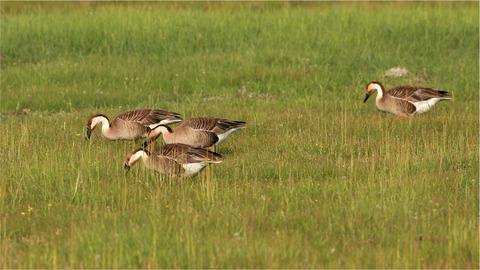当前位置:
X-MOL 学术
›
Ecol. Evol.
›
论文详情
Our official English website, www.x-mol.net, welcomes your
feedback! (Note: you will need to create a separate account there.)
Lack of conspicuous sex-biased dispersal patterns at different spatial scales in an Asian endemic goose species breeding in unpredictable steppe wetlands.
Ecology and Evolution ( IF 2.3 ) Pub Date : 2020-06-27 , DOI: 10.1002/ece3.6382 Qin Zhu 1 , Iderbat Damba 2, 3, 4 , Qingshan Zhao 2 , Kunpeng Yi 2 , Nyambayar Batbayar 5 , Tseveenmyadag Natsagdorj 5 , Batmunkh Davaasuren 5 , Xin Wang 2 , Sonia Rozenfeld 6 , Sachiko Moriguchi 7 , Aibin Zhan 3, 8 , Lei Cao 2, 3 , Anthony D Fox 9
Ecology and Evolution ( IF 2.3 ) Pub Date : 2020-06-27 , DOI: 10.1002/ece3.6382 Qin Zhu 1 , Iderbat Damba 2, 3, 4 , Qingshan Zhao 2 , Kunpeng Yi 2 , Nyambayar Batbayar 5 , Tseveenmyadag Natsagdorj 5 , Batmunkh Davaasuren 5 , Xin Wang 2 , Sonia Rozenfeld 6 , Sachiko Moriguchi 7 , Aibin Zhan 3, 8 , Lei Cao 2, 3 , Anthony D Fox 9
Affiliation

|
Dispersal affects the spatial distribution and population structure of species. Dispersal is often male‐biased in mammals while female‐biased in birds, with the notable exception of the Anatidae. In this study, we tested genetic evidence for sex‐biased dispersal (SBD) in the Swan Goose Anser cygnoides , an Asian endemic and IUCN vulnerable species, which has been increasingly restricted to breeding on Mongolian steppe wetlands. We analyzed the genotypes of 278 Swan Geese samples from 14 locations at 14 microsatellite loci. Results from assignment indices, analysis of molecular variance, and five other population descriptors all failed to support significant SBD signals for the Swan Goose at the landscape level. Although overall results showed significantly high relatedness within colonies (suggesting high levels of philopatry in both sexes), local male genetic structure at the 1,050 km distance indicated greater dispersal distance for females from the eastern sector of the breeding range. Hence, local dispersal is likely scale‐dependent and female‐biased within the eastern breeding range. These findings are intriguing considering the prevailing expectation for there to be female fidelity in most goose species. We suggest that while behavior‐related traits may have facilitated the local genetic structure for the Swan Goose, several extrinsic factors, including the decreasing availability of the nesting sites and the severe fragmentation of breeding habitats, could have contributed to the absence of SBD at the landscape level. The long‐distance molt migration that is typical of goose species such as the Swan Goose may also have hampered our ability to detect SBD. Hence, we urge further genetic sampling from other areas in summer to extend our results, complemented by field observations to confirm our DNA analysis conclusions about sex‐specific dispersal patterns at different spatial scales in this species.
中文翻译:

在不可预测的草原湿地繁殖的亚洲特有鹅物种在不同空间尺度上缺乏明显的性别偏见扩散模式。
扩散影响物种的空间分布和种群结构。哺乳动物的传播通常偏向雄性,而鸟类的传播通常偏向雌性,鸭科除外。在这项研究中,我们测试了天鹅雁性别偏向传播(SBD)的遗传证据,天鹅雁是亚洲特有的、世界自然保护联盟(IUCN)的脆弱物种,越来越多地限制在蒙古草原湿地的繁殖。我们分析了来自 14 个地点 14 个微卫星位点的 278 个鸿雁样本的基因型。分配指数、分子方差分析和其他五个种群描述符的结果均未能支持鸿雁在景观水平上的显着 SBD 信号。尽管总体结果显示群体内的相关性显着较高(表明两性的亲缘关系都很高),但 1,050 公里距离处的当地雄性遗传结构表明雌性距离繁殖范围东部的分散距离更大。因此,在东部繁殖范围内,局部扩散可能具有规模依赖性和雌性偏见。考虑到大多数鹅物种都对雌性忠诚的普遍期望,这些发现很有趣。我们认为,虽然与行为相关的性状可能促进了鸿雁的当地遗传结构,但一些外在因素,包括筑巢地点的可用性下降和繁殖栖息地的严重破碎化,可能导致了天鹅雁在当地缺乏SBD。景观水平。鸿雁等鹅物种典型的长距离换毛迁徙也可能妨碍了我们检测 SBD 的能力。 因此,我们敦促在夏季从其他地区进行进一步的基因采样,以扩展我们的结果,并辅之以实地观察,以证实我们关于该物种在不同空间尺度上的性别特异性扩散模式的 DNA 分析结论。
更新日期:2020-07-30
中文翻译:

在不可预测的草原湿地繁殖的亚洲特有鹅物种在不同空间尺度上缺乏明显的性别偏见扩散模式。
扩散影响物种的空间分布和种群结构。哺乳动物的传播通常偏向雄性,而鸟类的传播通常偏向雌性,鸭科除外。在这项研究中,我们测试了天鹅雁性别偏向传播(SBD)的遗传证据,天鹅雁是亚洲特有的、世界自然保护联盟(IUCN)的脆弱物种,越来越多地限制在蒙古草原湿地的繁殖。我们分析了来自 14 个地点 14 个微卫星位点的 278 个鸿雁样本的基因型。分配指数、分子方差分析和其他五个种群描述符的结果均未能支持鸿雁在景观水平上的显着 SBD 信号。尽管总体结果显示群体内的相关性显着较高(表明两性的亲缘关系都很高),但 1,050 公里距离处的当地雄性遗传结构表明雌性距离繁殖范围东部的分散距离更大。因此,在东部繁殖范围内,局部扩散可能具有规模依赖性和雌性偏见。考虑到大多数鹅物种都对雌性忠诚的普遍期望,这些发现很有趣。我们认为,虽然与行为相关的性状可能促进了鸿雁的当地遗传结构,但一些外在因素,包括筑巢地点的可用性下降和繁殖栖息地的严重破碎化,可能导致了天鹅雁在当地缺乏SBD。景观水平。鸿雁等鹅物种典型的长距离换毛迁徙也可能妨碍了我们检测 SBD 的能力。 因此,我们敦促在夏季从其他地区进行进一步的基因采样,以扩展我们的结果,并辅之以实地观察,以证实我们关于该物种在不同空间尺度上的性别特异性扩散模式的 DNA 分析结论。











































 京公网安备 11010802027423号
京公网安备 11010802027423号